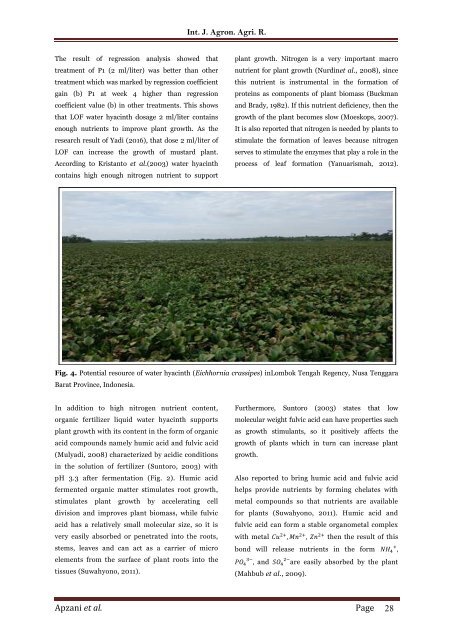Effectiveness of liquid organic fertilizer of hyacint (Eichhornia crassipes) Fermented by Trichoderma spp. for Growth of Lettuce (Lactuca sativa L.)
Abstract This research is important to be done with the aim to increase domestic lettuce production, development of area potency through the discovery of natural resources, and utilization of organic water hyacinth in Lombok island. This research was conducted at Green House Faculty of Agriculture University 45 Mataram. This study aims to determine the effectiveness of liquid organic fertilizer water hyacinth fermentation results Trichoderma spp. on the growth of lettuce. The research method used is experimental method with experiment in Green House. This research was designed using Randomized Complete Randomized Design (RAL) experiment with single factor experiment that is liquid organic fertilizer water hyacinth fermentation Trichoderma spp. which consists of 5 levels and 5 repetitions. The initial phase of the research was to arrange the experimental layout according to the treatment code of 25 experimental units, the planting of lettuce seeds, the provision of liquid organic fertilizer, irrigation, pest and weed management, and data collection. The next stage of data was analyzed by regression analysis to determine the effectiveness of fertilizer and the best dosage of fertilizer from the acquisition of regression coefficient value (b). Analsis results show that liquid organic fertilizer water hyacinth is effective in improving the growth of lettuce plants. Research shows that water hyacinth can be used as an alternative base liquid organic fertilizer that is cheap and easily available on the island of Lombok and has enough mineral content for the growth of lettuce plants.
Abstract
This research is important to be done with the aim to increase domestic lettuce production, development of area potency through the discovery of natural resources, and utilization of organic water hyacinth in Lombok island.
This research was conducted at Green House Faculty of Agriculture University 45 Mataram. This study aims to determine the effectiveness of liquid organic fertilizer water hyacinth fermentation results Trichoderma spp. on the growth of lettuce. The research method used is experimental method with experiment in Green House. This research was designed using Randomized Complete Randomized Design (RAL) experiment with single factor experiment that is liquid organic fertilizer water hyacinth fermentation Trichoderma spp. which consists of 5 levels and 5 repetitions. The initial phase of the research was to arrange the experimental layout according to the treatment code of 25 experimental units, the planting of lettuce seeds, the provision of liquid organic fertilizer, irrigation, pest and weed management, and data collection. The next stage of data was analyzed by regression analysis to determine the effectiveness of fertilizer and the best dosage of fertilizer from the acquisition of regression coefficient value (b). Analsis results show that liquid organic fertilizer water hyacinth is effective in improving the growth of lettuce plants. Research shows that water hyacinth can be used as an alternative base
liquid organic fertilizer that is cheap and easily available on the island of Lombok and has enough mineral content for the growth of lettuce plants.
Create successful ePaper yourself
Turn your PDF publications into a flip-book with our unique Google optimized e-Paper software.
Int. J. Agron. Agri. R.<br />
The result <strong>of</strong> regression analysis showed that<br />
treatment <strong>of</strong> P1 (2 ml/liter) was better than other<br />
treatment which was marked <strong>by</strong> regression coefficient<br />
gain (b) P1 at week 4 higher than regression<br />
coefficient value (b) in other treatments. This shows<br />
that LOF water <strong>hyacint</strong>h dosage 2 ml/liter contains<br />
enough nutrients to improve plant growth. As the<br />
research result <strong>of</strong> Yadi (2016), that dose 2 ml/liter <strong>of</strong><br />
LOF can increase the growth <strong>of</strong> mustard plant.<br />
According to Kristanto et al.(2003) water <strong>hyacint</strong>h<br />
contains high enough nitrogen nutrient to support<br />
plant growth. Nitrogen is a very important macro<br />
nutrient <strong>for</strong> plant growth (Nurdinet al., 2008), since<br />
this nutrient is instrumental in the <strong>for</strong>mation <strong>of</strong><br />
proteins as components <strong>of</strong> plant biomass (Buckman<br />
and Brady, 1982). If this nutrient deficiency, then the<br />
growth <strong>of</strong> the plant becomes slow (Moeskops, 2007).<br />
It is also reported that nitrogen is needed <strong>by</strong> plants to<br />
stimulate the <strong>for</strong>mation <strong>of</strong> leaves because nitrogen<br />
serves to stimulate the enzymes that play a role in the<br />
process <strong>of</strong> leaf <strong>for</strong>mation (Yanuarismah, 2012).<br />
Fig. 4. Potential resource <strong>of</strong> water <strong>hyacint</strong>h (<strong>Eichhornia</strong> <strong>crassipes</strong>) inLombok Tengah Regency, Nusa Tenggara<br />
Barat Province, Indonesia.<br />
In addition to high nitrogen nutrient content,<br />
<strong>organic</strong> <strong>fertilizer</strong> <strong>liquid</strong> water <strong>hyacint</strong>h supports<br />
plant growth with its content in the <strong>for</strong>m <strong>of</strong> <strong>organic</strong><br />
acid compounds namely humic acid and fulvic acid<br />
(Mulyadi, 2008) characterized <strong>by</strong> acidic conditions<br />
in the solution <strong>of</strong> <strong>fertilizer</strong> (Suntoro, 2003) with<br />
pH 3.3 after fermentation (Fig. 2). Humic acid<br />
fermented <strong>organic</strong> matter stimulates root growth,<br />
stimulates plant growth <strong>by</strong> accelerating cell<br />
division and improves plant biomass, while fulvic<br />
acid has a relatively small molecular size, so it is<br />
very easily absorbed or penetrated into the roots,<br />
stems, leaves and can act as a carrier <strong>of</strong> micro<br />
elements from the surface <strong>of</strong> plant roots into the<br />
tissues (Suwahyono, 2011).<br />
Furthermore, Suntoro (2003) states that low<br />
molecular weight fulvic acid can have properties such<br />
as growth stimulants, so it positively affects the<br />
growth <strong>of</strong> plants which in turn can increase plant<br />
growth.<br />
Also reported to bring humic acid and fulvic acid<br />
helps provide nutrients <strong>by</strong> <strong>for</strong>ming chelates with<br />
metal compounds so that nutrients are available<br />
<strong>for</strong> plants (Suwahyono, 2011). Humic acid and<br />
fulvic acid can <strong>for</strong>m a stable organometal complex<br />
with metal Cu 2+ , Mn 2+ , Zn 2+ then the result <strong>of</strong> this<br />
bond will release nutrients in the <strong>for</strong>m NH + 4 ,<br />
PO 3− 4 , and SO 2− 4 are easily absorbed <strong>by</strong> the plant<br />
(Mahbub et al., 2009).<br />
Apzani et al. Page 28


















